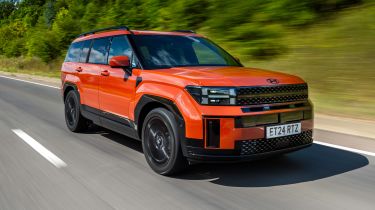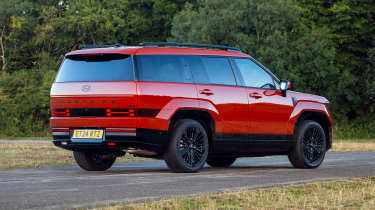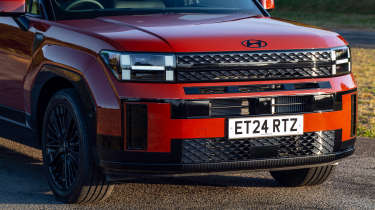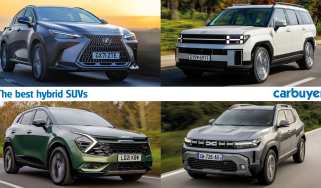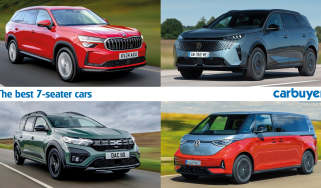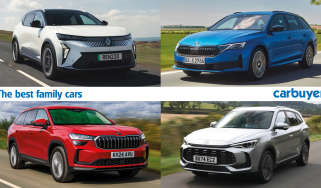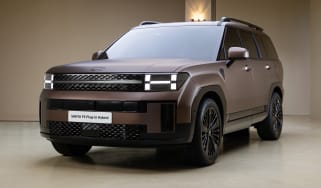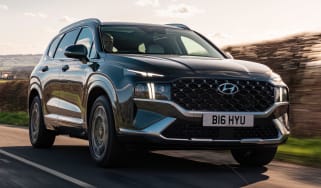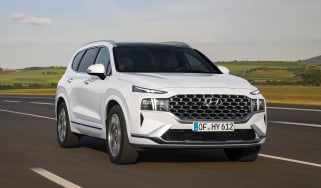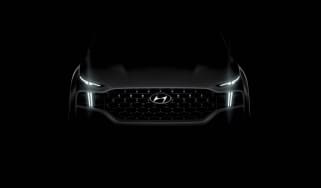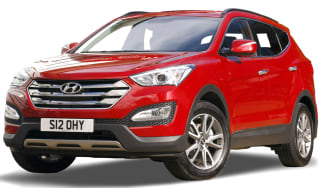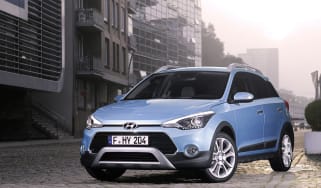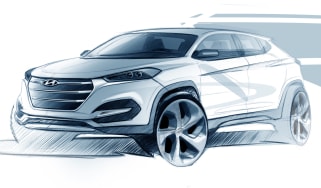Hyundai Santa Fe review – an arresting and upmarket seven-seater
“The latest Hyundai Santa Fe’s unapologetically chunky styling, impressive seven-seat practicality and quality interior make it a genuine Land Rover rival”
Pros
- Very practical
- Comfortable for all seven passengers
- High-quality interior
Cons
- Rivals feel better to drive
- More expensive than before
- No diesel option for towing
Verdict – is the Hyundai Santa Fe a good car?
While it's still early days, our time testing the Hyundai Santa Fe in South Korea and now the UK, shows it’s a more capable and appealing five, six or seven-seater SUV than its predecessor in almost every way. Hyundai has turned it up a notch in terms of its premium feel inside, with added tech and good quality materials which will help it appeal to not only family-car buyers, but also those who may be considering a seven-seater from premium rivals such as Land Rover. The entry-level Premium trim will offer more than enough content for most buyers, it’s just a shame the ride on large alloy wheels is a bit unsettled, and the hybrid’s petrol engine is eager to kick in at suburban speeds.
Hyundai Santa Fe models, specs and alternatives
The Hyundai Santa Fe is the South Korean brand’s flagship SUV, offering from five to seven seats and plenty of practicality for a large family. For this iteration, rather than trying to disguise its SUV proportions with wacky styling or sleek curves, Hyundai has instead designed the Santa Fe with unapologetically boxy, yet clean lines. We wouldn’t expect the Santa Fe’s looks to be particularly controversial with most buyers, though it’s at the rear where it could divide opinion with its unusually low-down taillights, and we found the Santa Fe seriously attention-grabbing as we drove it.
More reviews
Elsewhere the Santa Fe flaunts its chunkiness with large angular wheel arches and H-shaped LED daytime running lights. It’s a look that wouldn’t look too out of place next to the Hyundai Ioniq 5 EV, and is sure to have Land Rover Discovery owners doing a double-take.
The Santa Fe’s styling means it looks purposeful, and it appears as though Hyundai wants buyers to consider this iteration as a more rugged, outdoorsy car than before, evidenced by the brand’s heavy emphasis on its practical tailgate it says doubles up as a ‘terrace’ – a place where users might sit and admire the great outdoors after a day of hiking or other activity, for example.
In practice, though, we reckon most buyers of the Santa Fe will be those with big families in need of seven seats and generous boot space, and this is an area where it excels – there’s certainly enough space for every occupant, even in the back row.
As a result, the Hyundai Santa Fe’s rivals include other adventure-enabling cars such as the Land Rover Defender or Discovery, but Hyundai is positioning the Santa Fe as a slightly more high-end proposition than the old model, so it’s also taking on premium rivals such as the Audi Q7 or BMW X5.
Of course, rivals still include the likes of the Nissan X-Trail, Kia Sorento and Skoda Kodiaq. UK pricing for the Santa Fe starts from just under £47,000, which isn’t a huge increase over the outgoing car’s £45,000 price tag, especially given the extra kit and move further upmarket, but it does make it quite expensive when compared to rivals like the Kodiaq that starts from £36k.
All versions of the Hyundai Santa Fe are hybrid, with a full-hybrid and plug-in hybrid coming to the UK. We first tested the Hyundai Santa Fe on South Korea’s roads in hybrid guise, which uses a 1.6-litre engine and electric motor, and we’ve now also tried it out on Welsh roads. Despite having a combustion engine that’s pretty small for a car this size, the Santa Fe’s powerplant feels capable enough for most, although rivals such as the BMW X5 will be better suited to satisfying keen drivers. The Santa Fe is a model that will appeal more to those with a priority on space and comfort. While it can’t tow as much as some rivals, even the least capable Santa Fe can haul a 1,900kg trailer, which should be plenty for most drivers.
Trims are Premium, Ultimate and Calligraphy, and we reckon the first and most affordable is the one to recommend, with features like its swish infotainment, powered tailgate and heated front seats all standard. Ultimate adds some nice additions like a panoramic sunroof, while Calligraphy takes the luxury up a notch with Nappa leather upholstery, but also ratchets up the price to around £53k.
| Trim levels | Power options |
|
|
MPG, running costs & CO2 emissions
Every version of the Hyundai Santa Fe comes with some form of electrification, whether that be a hybrid or plug-in hybrid system. As a result, the Santa Fe is fuel efficient for such a large car with seven seats. Go for the plug-in hybrid and it can manage up to 38 miles on electricity alone. Read more about the Hyundai Santa Fe's MPG, running costs & CO2 emissions...
Engines, drive & performance
The Hyundai Santa Fe is no driver’s car, but it’s very comfortable and refined. Put your foot down, however, and the serenity of the cabin can be disturbed by a gruff engine note, so it’s best to drive in a leisurely manner. Read more about the Hyundai Santa Fe's engines, drive & performance...
Interior & comfort
Despite being a mainstream model, the Hyundai Santa Fe’s interior is more upmarket than you might expect. Good levels of standard equipment also mean you get a lot for your money. Read more about the Hyundai Santa Fe's interior & comfort...
Boot space, practicality & dimensions
The Santa Fe is a big car with seven seats which means it’s very practical for a large family. If you want to improve comfort for fewer people you can specify it as a six-seater with a middle row made up of two supportive captain’s chairs. Read more about the Hyundai Santa Fe's boot space, practicality & dimensions...
Reliability & safety
It’s still relatively early days to judge the Santa Fe in terms of reliability, but the brand generally performs well in terms of customer satisfaction and offers a competitive warranty. Unfortunately, a disappointing four-star Euro NCAP rating somewhat lets the Santa Fe down. Read more about the Hyundai Santa Fe's reliability & safety...
Hyundai Santa Fe alternatives
The Hyundai Santa Fe may be a mainstream large SUV, but its quality means it straddles the line between that class and more upmarket rivals.
Premium SUVs and 4x4s
It might be Hyundai's flagship SUV, but the South Korean brand has only recently begun challenging the likes of Land Rover, BMW and Audi. If an affordable alternative with a long warranty sounds appealing, look no further than the Santa Fe.
- Land Rover Defender
- Land Rover Discovery
- BMW X5
- Audi Q7
Large SUVs
While the large seven-seat SUV class isn't as packed out as the mid-size SUV arena, there are still some excellent rivals, including the Skoda Kodiaq that scooped our Best Large Family Car title.
Should you buy a Hyundai Santa Fe?
The latest Hyundai Santa Fe is definitely worth your consideration if you have a large family and the need for a large SUV to ferry everyone around in comfort. We’re fans of its unashamedly boxy SUV look, and we think it feels more upmarket than you might expect inside.
There are loads of practical features, some genuine off-road capability and lots of equipment as standard. Sure, it’s not the most exciting thing to drive, but that’s not really the point here, and for most buyers it will be everything they’re looking for in a family car.
What is the Carbuyer pick of the Hyundai Santa Fe range?
We think most buyers will be best off sticking to the entry-level Premium trim for the Santa Fe because it gets all the kit you could conceivably need, and yet it still feels upmarket. If you’re able to charge its battery at home, it’s worth seriously considering the Plug-in Hybrid model because you could save a lot of money on fuel, especially when tackling shorter trips around town. It’s probably best to stick to the standard Hybrid otherwise.
How we tested the Hyundai Santa Fe
We tested the Hyundai Santa Fe when it launched in South Korea, but have also tested it various times since in the UK in Plug-in Hybrid and Hybrid specifications.
Which Is Best?
Cheapest
- Name1.6 TGDi Hybrid Premium 5dr Auto
- Gearbox typeSemi-auto
- RRP£47,200
Most Economical
- Name1.6 TGDi Plug-in Hybrid Premium 5dr 4WD Auto
- Gearbox typeSemi-auto
- RRP£52,475
Fastest
- Name1.6 TGDi 239 Hybrid Premium 5dr Auto
- Gearbox typeSemi-auto
- RRP£47,700
